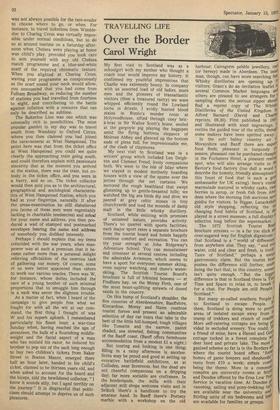TRAVELLING LIFE
Over the Border
Carol Wright My first visit to Scotland was as a schoolgirl with my mother who thought a coach tour would improve my history. It confirmed my youthful impressions that Charlie was extremely bonny. In company with an assorted load of old ladies, mute men and the pioneers of transatlantic visitors (then a treasured rarity) we were whipped efficiently round the Lowland lochs in drizzle. I avidly hunted blood stains in Rizzio's murder room at Holyroodhouse, sifted through cosy brica-brac in Sir Walter Scott's home, smiled at the gargoyle pig playing the bagpipes amid the flying buttress elegance of Melrose Abbey and glanced up the bottom ends of glens full, for impressionable me, of the clash of claymores.
My next visit to Scotland was in a writers' group which included Len Deighton and Clement Freud, lively companions both. We went to the isle of Islay where we stayed in modest motherly boarding houses with a view of the spume over the jetties through the net curtains. We motored the rough heathland that swept glistening up to gentle-breasted hills; we watched the big sea birds dip and dive; we peered at grey celtic stones in tiny churchyards and toed the mounds of damp malt in the little whisky distillery. Scotland, while enticing with promises of untamed nature, provides activity. There's no quarrel with sports facilities; each major sport rates a separate brochure from the tourist board and hotels happily combine comfort and recreation. You can try your strength at John Ridgeway's Adventure School. You can mountaineer and orienteer at several centres including the admirable Aviemore, which seems to have a sport for everyone; summer skiing, even osprey watching, and there's waterskiing. The Scottish Tourist Board's brochure is full of bikinied bosoms — at Findhorn bay, on the Moray Firth, one of the most heart-uplifting sprawls of duned sands in the country.
On this hump of Scotland's shoulder, the five counties of Aberdeenshire, Banffshire, Kincardine, Moray and Nairn combine tourist forces and present an admirable selection of day car tours that take in the best of the little hill-humped, tough villages like Tomatin and the narrow, pastel shaded, sea streeted, fishing communities of the Banff coast. (Banff offers farmhouse accommodation from a modest £1 a night.) But touring and looking is one thing; filling in a rainy afternoon is another. Scots may be proud and good at setting up evocative battlefield exhibitions, as at Culloden, near Inverness, but the dead are not cheerful companions on a dripping day; far more sociable are craftsmen. In the borderlands, the mills with their adjacent mill shops welcome visits and in Selkirk there's a handloom to try the amateur hand. In Banff there's Portsoy marble with a workshop on the old harbour; Cairngorm pebble jewellery, rugl (or heresy) made in Aberdeen. The inner man, though, can have more searching full Whisky distilleries are opening up t° visitors; Grant's do an invitation leaflet several Common Market languages aud others are pleased to see strangers for sampling dram; the serious sipper should find a reprint copy of The WhiskY Distilleries of the United Kingdom bY Alfred Barnard (David and Chad!! reprints, £6.30). First published in 188!' and illustrated with steel engravings, 1,1 recites the guided tour of the stills, though some makers have been spirited away. f In the soft balmy country air d, Morayshire and Banff there are supeP food finds; pheasant in burgundy (11 season, pheasant can be purchased cheaPlY in the Fochabers Hotel, a pleasant restirli spot, who will also arrange visits to tl Bavtor's food factory (too dull a word °. describe the homely, friendly atmosphere or, this fount of food that is such a go°', ambassador for UK eating). here's vintag` marmalade matured in whisky casks, raslY berries in syrup, or fresh fish from Abet deen where the morning fish auctions sP°ff guides for visitors. In Biggar, Lanarkshire old style shopping, reflecting the 0,11 changing food habits of Scotland, is (Of played in a street museum; a full displaY° selection long before the supermarket. The 1972 Scottish Tourist Boar! brochure stresses — in a far too slick all' over-sugared way for English digestions that Scotland is a "world of difference from anwhere else. They say, "and ever water, cold and clear and fresh, is itself Taste of Scotland," perhaps a unicIll gastronomic claim. But the tourist boar' pushes the difference still further, uncle,f lining the fact that, in this country, scene' isn't quite enough. "But the bigg°. difference is that in Scotland there is TIO, Time and Space to relax in, to break for a chat. For People are still Peopler Scotland." But many so-called southern People gc to Scotland to escape People. F.A them, Scotland is doing more to pros/I,' areas of isolated escape away from t' tramp of trekkers and crunch of coactle More self-catering cottages are being P,rt vided in secluded scenery. You could, ll a friend of mine, have a Hansel and Gre,i; cottage tucked in a forest complete vril deer herd and private lake. The most ganised scheme so far is in the Borders arr, where the tourist board offers forrfi, homes of game keepers and shepherds,' rents from £10 a week; simple corulc„ being the theme. More in a comma!, complex are university rooms at and Dundee offered by the Erna Low TO' Service in vacation time. At Dundee g° canoeing, sailing and pony-trekking tar are available near the university and Stirling units of six bedrooms and 100 are available for families or groups.










































 Previous page
Previous page